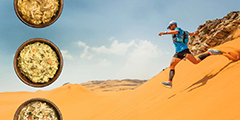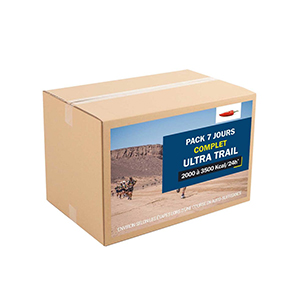Guide : How to plan your food for Self-sufficient running ?

For many years, Freezedried & Co has been supporting numerous participants in multi-stage races such as the Marathon des Sables, the Volcano Ultra Marathon, and the Half Marathon des Sables by providing them with the necessary nutrition to endure this kind of effort.

|
The multi-stage races are ultra-trails with several specificities. First, they take place over several days. Each day consists of a stage, and the total distance varies depending on the race. It can range from a few dozen kilometers to several hundred. Secondly, most of them require complete self-sufficiency in food. Each participant is required to carry all their meals on their back. This is known as a self-sufficiency race.
For food autonomy, freeze-dried meals appear to be the ideal solution due to their lightness, variety, and nutritional richness. With over 10 years of experience in this field, we share with you in this article our tips for managing your nutrition during the Marathon des Sables, the queen of multi-day races. Of course, these tips are also valid for other self-sufficiency races.
Our tips for good nutrition during the MDS
Here are some tips that can help you choose your nutrition. Keep in mind that each person has their own needs and is free to choose the type of food that suits them.
- The macronutrient distribution recommended by the Marathon des Sables organization is 15% protein (1g = 4 kcal), 30% fat (1g = 9 kcal), and 55% carbohydrates (1g = 4 kcal).
- Breakfasts based on muesli are generally chosen by participants. In addition to providing energy and fiber, they are easy to digest and prepare. You can complement it with a dairy product or a rehydrated compote.
- During the race, it is recommended to consume energy bars every 30 minutes to 1 hour and energy drinks diluted in 0.60 to 0.80 liters of water.
- A recovery drink to be taken within 30 minutes after the end of your stage is also recommended.
- Don't forget to have a fresh recovery snack rich in complex and simple carbohydrates like rehydrated tabbouleh, which is easy to prepare with cold water and very digestible. Fruits rich in minerals to counterbalance the losses due to sweating are also a good idea.
- Beef jerky is ideal for post-exercise as it is rich in protein and salt, promoting good muscle recovery.
- In the evening, opt for a hot and hearty meal as the nights are cool (below 10°C). A dessert is a good idea for an additional energy intake while enjoying yourself.
- Rich in fats, dried fruits help increase the number of calories, such as walnut kernels or almonds.
- Test your meals before the race, so you'll be better prepared and more confident.
- Vary the recipes as much as possible to avoid monotony. Meals should remain a moment of pleasure.
- Depending on your sensitivity, foods should be lightly or not at all spiced to avoid irritating digestion already put to the test. However, on the rest day, you can indulge a bit and bring some variety and exoticism.

What do ultra-runners eat during the Marathon des Sables?
Need some inspiration? Here is the nutritional plan of a Lyophilise & Co ambassador, Julien Chorier (in partnership with EffiNov Nutrition). It is not recommended to copy it exactly. What suits his body may not suit yours. This is why it is important to taste and test before the race...
Click on the image to enlarge
Based on the various tips above, we have created a food pack for self-sufficiency races like the Marathon des Sables. Improved year after year thanks to your feedback, they comply with the race regulations.
- 7-day pack - Self-sufficiency race - 2,500 kcal/day
- Morning: 1 breakfast
- During the race: bars and energy drinks
- At the end of the race: recovery drink, tabbouleh, beef jerky.
- Evening: freeze-dried meal and dessert.
Its main strength? Variety. We include different meals each day to avoid monotony. Moreover, we have selected the best recipes (both in terms of taste and digestion) to compose them. Finally, know that they are customizable according to your tastes and dietary restrictions if one or more recipes do not suit you. To do this, simply contact us by email: team[at]freezedriedandco.com.
How to repackage?
The freeze-dried meals included in our packs are delivered in their original packaging. If you plan to participate in a self-sufficiency race soon, you know that participants repackage their food.
While we do not normally recommend repackaging a freeze-dried meal yourself because it becomes fragile once exposed to the air, it is different for this type of event. It is essential to save weight but also volume. The bags are initially designed to serve as a bowl allowing rehydration directly inside, so the brands make them bulkier than necessary.
To repackage your products, simply take freezer bags and a vacuum sealer. Note that any food out of its original packaging must have the nutritional label of the concerned product. Discover in this video how Vincent Hulin, a seasoned ultra-runner, repackages his products.
How to heat water on the bivouac to prepare your meal?
Besides tabbouleh, breakfasts, and desserts that rehydrate cold, all freeze-dried products rehydrate with hot water.
There are several ways to heat water. Here are our tips. If you have any, feel free to share the information with us:
- To heat water for your freeze-dried meal, it is not necessarily essential to have boiling water. For example, you can plant your water bottle in the sand and wait for the water to heat up with the sun. You will have a lukewarm freeze-dried meal, but without too much preparation.
- You can also choose to have an alcohol stove with alcohol tablets along with a pot to heat your water. This option is heavier but allows you to be self-sufficient. Gas is not allowed.
- Sometimes, it may be possible to make a fire with small wood found near the campsite.
Most participants opt for option number 2. Here is an example of a pot and light stoves suitable for the Marathon des Sables:
How to stay hydrated during the race?
In addition to nutrition, hydration is not to be neglected. An energy drink is prepared according to the temperature of the race. The hotter it is, the more hypotonic the drink should be, meaning less concentrated than when it is cold. This is the case for the Marathon des Sables. The prepared drink should be consumed in small sips. This represents about 10 cl every 10 to 15 minutes. For better absorption, alternate with a bottle of plain water.
Electrolyte tablets are also recommended. When you sweat, you lose minerals. These tablets can help stabilize them. Remember to stay hydrated even if you are not thirsty.
To conclude, here is what Vincent Hulin, a seasoned ultra-runner, says in his book "Coureur de l'extrême": "For me, the Marathon des Sables is a new discipline, and above all a new adventure. Having completed the Diagonale des Fous and the Ultra-Trail du Mont-Blanc is one thing, running in 40-degree heat in the shade, in the sand, with a backpack of over ten kilos on your back, is another!"
So... Who's up for the challenge?

